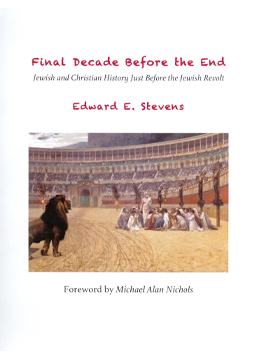One Column Page
and responsive to boot
Vespasian Sent to Crush the Revolt
by Edward E. Stevens
This article appeared in the 2022 Fall issue of Fulfilled! Magazine
In our last article, we noted that Cestius Gallus inexplicably withdrew from Jerusalem and suffered a miserable defeat at Beth-Horon (Oct 27, 66). Immediately afterward he sent swift messengers to Nero to inform him of the worsening rebellion in Judea, and to ask for reinforcements [Wars 2.558 (2.20.1)].

Nero’s Parousia to Greece
At that time (early Nov 66), Nero was in Greece participating in the games and art contests (Wars 2.558 [2.20.1]; 3.1-8 [3.1.1-3]). Vespasian and his legion of powerful soldiers accompanied Nero to Greece as his bodyguards. Nero remained in Greece for over a year (from Sept 66 until Dec 67). This extended visit of Nero to Greece was referred to by some of the contemporary Greek writers as the parousia (visitation) of Nero. It was not a one-day event, but instead an extended visit of a year and three months. Then in Dec 67, when Nero received word from Rome about a conspiracy against him, and a mutiny of some troops in the West, his “parousia” (extended visit) to Greece came to an abrupt end, and he hurried back to Rome.
This helps us understand that the Parousia of Christ was not a one-day event. It was an extended visitation for the purposes of relieving, rescuing, and rewarding His saints, as well as judging and pouring out His wrath on His enemies. That rescue of the saints and wrath-outpouring on the Jews obviously took longer than one day (or even one year) to accomplish. It was more like seven years (AD 66-73). For a detailed explanation of the meaning of parousia, see Adolf Deissmann’s book, Light From the Ancient East, Chapter 4.
Nero Sent Vespasian and Titus
As soon as Nero heard the bad news from Cestius Gallus (early Nov 66), he dispatched Vespasian to crush the rebellion (Wars 3.1-8 [3.1.1-3]). But it took several months for Vespasian and Titus to assemble their troops and plan their attack.
During that winter delay (Nov 66–Mar 67) the Zealots gathered in Jerusalem to organize their new government and select governors (generals) for each of the seven regions of Palestine (Wars 2.562-568 [2.20.3-4]; Wars 3.54 [3.3.5]). This was when Josephus was appointed general over the entire Galilean region, with his strongest fortress in Jotapata in the middle of Galilee (Wars 2.573 [2.20.6]; 3.111 [3.6.1]; 3.141-142 [3.7.3]).
Vespasian sent his son Titus by fast boat to Alexandria in Egypt to fetch the fifth and tenth legions and march them quickly along the coast to Caesarea for the winter, and then on to Ptolemais in early Spring (Wars 3.8 [3.1.3]).
Meanwhile, Vespasian hurried through Greece to cross the Hellespont near Troas, and then followed the major trade routes through Turkey to reach Antioch (capital of Syria) by February 67, where the fifteenth legion and remnants of the twelfth legion were waiting (Wars 3:65 [3.4.2]; 5:41 [5.1.6]).
Vespasian spent the winter (Dec 66 to Mar 67) in Antioch meeting with his military advisors (including Agrippa II), planning his battle strategy, and assembling the legions, along with Agrippa’s soldiers and cavalry and other auxiliaries and mercenaries sent from the surrounding nations which were allied with Rome. In the Spring (AD 67), Vespasian marched his assembled forces to Ptolemais to join with Titus’ troops. This was a massive fighting force of almost 60,000 soldiers (Wars 3.8 [3.1.3]; 3.29 [3.2.4]; and 3.64-69 [3.5.2]).
Roman Troops at Armageddon
Both Cestius Gallus (Fall 66) and Vespasian (Spring 67) assembled their troops at Ptolemais, the coastal city at the edge of the Plain of Megiddo (Hebrew Har-Magedon, cf. Rev 16:16). Thus, the Romans launched their attack from Armageddon! The strategy of Vespasian was to eliminate all of the rebel forces from Galilee in the north and push them all toward Jerusalem in the south.
One of the most decisive battles in the Galilean campaign was fought at the mountain fortress of Jotapata where Josephus had his headquarters. After a siege of forty-seven days, Vespasian finally overwhelmed it and captured its commander Josephus (Aug 67). When brought before Vespasian and Titus, Josephus predicted that Vespasian would become emperor. Vespasian thought that was nonsense, but spared his life in order to see if the prediction might come to pass.
For the next two years Josephus was held in chains in the Roman camp, during which he wrote a lot of notes about the war, which he used afterward in Rome to compose his Wars (AD 78) and Antiquities (AD 93). Josephus was used as a hostage at first, and then as a voice to urge the Zealots to quit the rebellion. In AD 69, after four emperors died in quick succession (Nero, Galba, Otho, Vitellius), and Vespasian became Emperor, Josephus was then freed from his chains, adopted into Vespasian’s Flavian family, and renamed Flavius Josephus.
During his military operations in Galilee (Mar–Nov of 67), Vespasian captured many Jewish prisoners, and held them captive at the stadium in Tiberias until they could be dispersed. Twelve hundred of the elderly were put to death. Six thousand of the youngest and strongest were sent to Corinth to dig the canal across the isthmus. The remaining 30,400 captives were sent to Agrippa II to be sold into slavery (Wars 3:540 [3.10.10]). Vespasian continued crushing all Zealot strongholds in Galilee, leaving no pockets of resistance behind, and pushing everything ahead of him toward Jerusalem. By November 67, Vespasian had subjugated all of Galilee.
Zealots Prepare for the War
However, while Vespasian was up north in Galilee, armed groups of Jewish bandits and rebels plundered and pillaged all over the Judean countryside in the south. And during the winter (Dec 67–Mar 68), while the Romans were quartered in Caesarea, the Zealots were extremely busy stockpiling supplies and fortifying their defenses in Jerusalem. Refugees from Galilee and all over Palestine were fleeing to Jerusalem. Plus, many others from outside Palestine brought supplies to Jerusalem and joined in the war effort.
There were struggles for supremacy between the various Zealot leaders in Jerusalem, which left them a lot weaker than they would have been if they had united together against the Romans. As a result of that rivalry during the winter of Dec 67–Mar 68, the Zealots split into two factions: one under the leadership of Eleazar b. Ananias, and the other under John of Gischala.
Each of the Zealot leaders wanted to get into the top leadership position during the war, so that he could become the new world ruler after the Romans were defeated. They burned each other’s supplies and killed each other’s soldiers. They never imagined that their internecine strife weakened all of them so much that they were no match for the Roman forces. They assumed (fatally) that God would not allow the Temple and Jerusalem to be captured by the Romans.
Rebels Pushed Toward Jerusalem
In March of 68, Vespasian and Titus began their Spring campaign to clear out the resistance in all areas outside of Judea and drive them toward Jerusalem. Vespasian believed that once all the rebels fled to Jerusalem they would weaken themselves by internal fighting and thus make his task a lot easier. He was right. That is exactly what happened.
By the end of Spring (late May of 68), Vespasian had subdued all of Galilee, Samaria, Decapolis, Perea, western Judea, and Idumea. The stage was now set for the attack on Judea and Jerusalem. Then Nero died (June 9, 68), forcing Vespasian to suspend his operations until he could hear more about the situation in Rome. We will pick up at this point in our next article.
A Closing Observation
It is extremely odd that Josephus never mentions Christians being involved on either side of the war (Jewish or Roman). He mentions Pharisees, Essenes, Sicarii, and Zealots as participating on the Jewish side, but there is nothing about any Christians contributing to either side, or even being present on the historical scene either during or after the war.
Furthermore, in my own studies of the first-century church in the book of Acts and other New Testament documents, I was bewildered by the radical contrast between the intense missionary and literary activity of the saints before AD 66, and their utter silence and apparent absence after AD 70.
And there are many Christian historians and patristic scholars who likewise note that all mention of Christians and their activity “vanished without a trace” (Hans Conzelmann) and were “nowhere to be found” (Charles Hill) after the Zealot rebellion began in AD 66.
That was a very strange silence and absence. What caused it? Our previous articles have shown that there must have been a rapture. If you wish to know more about that, simply send me an email request for all of the historical documentation for it.
Comments:
Your honest review will help others in their search for truth. If you must leave a negative review please be gracious.
Rather, speaking the truth in love, we are to grow up in every way into him who the head, into Christ . . . .
(Ephesians 4:15)
We have migrated to "Disqus" commenting software. Older comments (if any) are archived below, but any new comments on this page will be handled by Disqus. If you are not familiar with "Disqus," click here for more information. You don't need a Disqus account to post comments, however, without an account you won't be notified if someone responds to your post.
Archived Comments:
Katrina, November 25, 2022
I would like to see what you have to share about rapture. I assumed there were no Christians because they fled as Jesus told them to when they saw armies surrounding Jerusalem. Fulfilled
Fulfilled